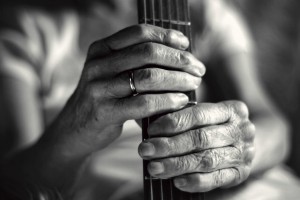It’s a Thursday afternoon, and one of Roman Music Therapy Services lead therapists, Laetitia Brundage, has pulled up in front of the home where she will be seeing her next clients. 
Inside, ten to twelve women ranging in ages from nineteen to forty-five wait in the living room for Laetitia’s arrival. With couches moved around to form the shape of a ‘U’, participants in the upcoming music therapy session are asked to pick their instruments. Once everyone is outfitted, Laetitia opens the session with a check in, finding out where each member of the group is at, emotionally, that day. Then she leads the group with a song to gather everyone together, breaking the ice and setting the tone. A rhythm everyone can play is picked, something that offers a beat for participants to land on as they drum. Sometimes it’s ‘Boston, Massachusetts’, other times Laetitia asks if the women would like to offer the mantras they say to themselves to get through a tough challenge or a rough day.
This home is the residence of an inpatient substance use disorders treatment facility specifically for women. The women in recovery are typically there for six to twelve months and engaged in various therapies and life building sessions.
While many people are familiar with music therapy in after school programs or within the setting of nursing homes, they are less familiar with music therapy playing a role in the treatment of mental illness, such as PTSD, anxiety and substance use disorder, to name only a few. Laetitia helps the women in this group identify, process and develop coping mechanisms surrounding their emotions, as well as build resiliency and gratitude. By sharing their emotions with the group, displaying respect for one another and listening to each other, as well as a willingness to explore their personal experience with treatment, the goal is to increase a participant’s potential success in sobriety after leaving the supportive and contained environment of the house.
Much of the feedback Laetitia has received after her sessions is positive. One woman revealed that “music really turned my attitude around”. Another shared that it was “really cool to take all these emotions and put them into song” after a session of songwriting with her peers.”
Laetitia is honored to be part of the progress these women are making.“It’s such different work…it’s very rewarding to go into this amount of depth with people.” The women have been extremely open and Laetitia says working with them has been “really beautiful…I feel like I’m making a real difference in their treatment and giving them another tool.”
After 45 minutes of music, the session comes to a close. Typically, the group ends with a mandela, an exercise that has one person begin a beat, followed by the next person, followed by the next and so on until everyone in the circle is contributing their own music. It shows the women that while they maintain their group cohesion, they still retain their individuality. And just as they started, they finish one by one, until there is a lone drummer, before they too fall silent and the group session concludes until next week.
If you, or anyone you know, is struggling with a substance use disorder, please contact the Substance Abuse and Mental Health Services Administration (SAMHSA) for more information and help.
If you would like more info on music therapy and it’s use during treatment and recovery, please contact us.

 Music therapy has been recognized and supported in the mental health field for many years. In the early history of music therapy, musicians worked with veterans from World War 2 playing songs in hospitals or rehabs. These musicians and surrounding staff saw noticeable changes in the veterans mood and affect. The field has grown largely since then, working with a range of demographics, disabilities, in such settings as; mental health, special education, hospice, nursing homes, and hospitals.
Music therapy has been recognized and supported in the mental health field for many years. In the early history of music therapy, musicians worked with veterans from World War 2 playing songs in hospitals or rehabs. These musicians and surrounding staff saw noticeable changes in the veterans mood and affect. The field has grown largely since then, working with a range of demographics, disabilities, in such settings as; mental health, special education, hospice, nursing homes, and hospitals.